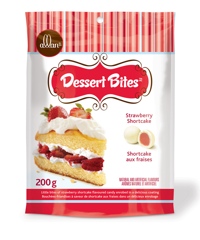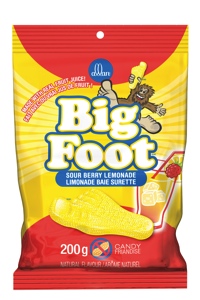
Sweet and sinful
By Carol Neshevich
Business Operations Food Trends Confectionery Ingredients & Additives candy chocolate cocoa indulgencePremium quality and unique flavour combinations are encouraging even the most health-conscious consumers to indulge in the occasional chocolate or candy treat
There’s no denying it – health concerns are a driving force in the food industry these days. Today’s consumers are increasingly demanding that their meals and snacks pack plenty of fibre, vitamins, nutrients and antioxidants, while at the same time minimizing all the bad fats, sugar and sodium. But when it comes to confectionery items like chocolate and candy, it seems Canadians still love to treat themselves to indulgent sweets from time to time.
“Confectionery is definitely about indulgence and happiness,” says John Phillipson, vice-president for Confectionery at Toronto, Ont.-based Kraft Canada. “In tough times, small indulgences are often what consumers turn to for happiness.” Still, as Canadians become more concerned with healthy foods, the confectionery space is undoubtedly being affected in a couple of interesting ways: one being the desire for smaller portions and bite-size treats; and the other being the “worth it” factor. “People are saying, ‘If I’m going to indulge in something, it really better be worth it,’” says Phillipson, noting that today’s confectionery consumer is frequently looking for very high quality and unique flavour combinations.
To answer the call for compelling flavour combinations in a high-quality product, Kraft has recently introduced three new premium Cadbury Dairy Milk chocolate bars that combine sweet and salty tastes: Pretzel & Peanut Butter, Toasted Coconut & Cashews, and Honey Roasted Cashews & Hazelnuts. “We’ve had great success with all of these,” says Phillipson.
At Vancouver, B.C.-based Purdy’s Chocolates Ltd., head chocolatier Gary Mitchell has also been working hard to come up with some new and interesting – not to mention quite sophisticated – flavour combinations. “We’re working on a tiramisu dessert chocolate with mascarpone cheese and whipped cream, Kahlua, and it’s made in a dessert cup,” says Mitchell. “Cheese and chocolate is one of my new frontiers.” The chocolatier recently introduced a Milk Chocolate Pear Lemon Caramel for spring, and he speaks with great pride about his award-winning Savory Brie Cheese and Fig Truffle. “Today’s consumers are looking for unusual tastes, unusual textures – they want to be entertained,” he adds, noting that this is a trend that’s evident in every aspect of the food business these days, from high-end gourmet meals to baked goods and snack foods.
Following this same trend toward unique, upscale flavours, in January the Allan Candy Company Ltd. introduced a new chocolate and candy line called Dessert Bites. These small treats – either coated in chocolate or a yogurt candy coating – have “a flavoured soft and chewy candy core that tastes exactly like that dessert,” says James Benson, director of Marketing and Innovation for Mississauga, Ont.-based Allan’s. Filling varieties include Chocolate Raspberry Cheesecake, Key Lime Pie, Apple Pie and Strawberry Shortcake.
Allan’s Dessert Bites also reflect the other big trend that’s sweeping the confectionery sector – the trend toward smaller, bite-size indulgences. “It’s an indulgence-first item, but with portion-controlled pieces. So you can have a handful, and you can enjoy that indulgent moment without feeling like you’ve overdone it,” says Benson. While the portion-controlled snack trend started with the 100-calorie chocolate bars and candy packs that were first introduced a few years ago – which remain very popular in the segment – Benson feels that bite-size treats are the next evolution of the trend. “If you can deliver indulgence but in a portion-controlled size, it takes a little bit of the guilt out of it,” he says, “and that’s why the ‘pieces’ segment is growing so substantially.”
Many of these “pieces” come in resealable packages, so consumers can grab a handful of chocolate treats and then just reseal the pack and put them away. “They may not contain a specific calorie count against them [like the 100-calorie bars], but consumers know how to navigate and say, ‘I’ll just have a little piece of that,’” adds Phillipson. Kraft has been enjoying great success with its Cadbury Pieces line, featuring Caramilk Secrets, Dairy Milk Buttons and Cadbury Crunchie Clusters, all of which come in resealable packages. This year the trio of bite-size products were recognized with a Product of the Year award in the Confectionery category.
Interestingly, despite the trend toward healthier eating, chocolate sales are actually increasing overall in Canada. According to a 2011 Euromonitor International report called Confectionery in Canada, sales of chocolate in Canada grew by almost three per cent in 2010 to $2.5 billion. The report predicts the chocolate category will continue steady growth of about two per cent per year until 2015, with sales growth being driven primarily by bite-size chocolates in resealable packages, as well as by premium chocolate products, including dark chocolate and chocolate made with higher-quality cocoa beans.
Mitchell can attest to the increasing popularity of dark chocolate. “We used to sell way more milk chocolate than dark chocolate,” he says, but the dark chocolate sales are quickly catching up. “It’s not 50/50 yet, but getting close.” Mitchell is fairly certain that this is because of the purported health benefits of dark chocolate, such as its high antioxidant content. “It also makes you feel good,” he adds. “It acts as a natural anti-depressant; it’s good for all things.”
To appeal to those interested in chocolate with health benefits, Purdy’s offers a 70-per-cent dark chocolate bar with dried goji berries and cocoa nibs, as well as a 70-per-cent dark chocolate bar with blueberries and almonds. Goji berries are high in antioxidants and various nutrients, as are blueberries, so the combination of purer dark chocolate and these superfruits makes them very appealing on a health level. Mitchell says these have been available for several years now, and are selling quite well, although they’re by no means a top seller for Purdy’s. The top sellers for the company remain their classics: Sweet Georgia Browns (roasted and salted Georgia pecans topped with caramel and milk chocolate) and Hedgehogs (milk chocolates with hazelnut).
While chocolate in general is trending upwards, it seems the sugar confectionery market, including licorice, chewy candy, lollipops and mints, is trending down. The Euromonitor report projects a steady decline overall in sugar confectionery sales of about one per cent per year until 2015. According to the report, this is largely attributable to health concerns – both dietary and dental – as well as to a declining population of children in Canada, who tend to be the main consumers of candy products.
Because of this, “manufacturers are placing a greater emphasis on product differentiation through natural ingredients,” says Benson. For example, Allan’s has reformulated its classic Big Foot candy to include real fruit juice in the recipe. “So it’s a little ‘better for you.’ Moms can buy it for their kids and feel better about it,” he says. The other change to Allan’s Big Foot product also fits the concurrent confectionery trend toward interesting flavour combinations. “We’ve expanded that line and added a set of unique and very trending flavours like Sour Berry Lemonade and Orange Cream Pop,” adds Benson.
Kraft has done something similar with its popular Trident Layers line – a three-layer sugar-free gum with a colourful candy layer in the middle, first introduced in 2010. The  original flavour combinations included Cool Mint and Melon Fresco, Wild Strawberry and Tangy Citrus, and Green Apple and Golden Pineapple. This June the company will introduce two new flavours: Mango Peach and Cherry Lime. Such flavour combinations really reflect a modern consumer’s tastes, says Phillipson, who adds that he can’t imagine these flavour combos succeeding 20 years ago when countless Canadians hadn’t even tried a real mango before.
original flavour combinations included Cool Mint and Melon Fresco, Wild Strawberry and Tangy Citrus, and Green Apple and Golden Pineapple. This June the company will introduce two new flavours: Mango Peach and Cherry Lime. Such flavour combinations really reflect a modern consumer’s tastes, says Phillipson, who adds that he can’t imagine these flavour combos succeeding 20 years ago when countless Canadians hadn’t even tried a real mango before.
Across the board, from chocolate to candy to gum, unique flavour combinations and high-quality, portion-controlled indulgent treats are what most Canadians are now looking for when it comes to confectionery. Are health concerns an issue? Of course – but only to a certain extent. “From all the research that we’ve done, it’s pretty apparent: consumers tell us straight out, in very clear terms, that a treat is a treat and you need to be careful about how far you move into a healthier space,” says Benson. “In this space, generally, it’s more about the sinful indulgent moment than it is the healthy benefit.”
Print this page
